Choosing the best B2B data providers in the USA is essential for sales, marketing, and compliance teams that want to connect with the right accounts and maintain accurate customer records. The U.S. market is massive and competitive, with millions of companies across every sector and strict privacy rules shaped by the California Consumer Privacy Act (CCPA). Not every global provider delivers the same depth of U.S. coverage, and not every platform offers structured, compliant, and continuously updated data.
This guide compares 10 of the leading U.S. B2B data providers across coverage, update frequency, integrations, and pricing. It also highlights how InfobelPRO provides verified bulk datasets that support CRM enrichment, account-based marketing, and compliance workflows at scale.
The U.S. B2B Data Landscape
The United States has the largest and most diverse business ecosystem in the world, with more than 70 million businesses ranging from small proprietorships to global enterprises (U.S. Small Business Administration, 2025). Over 99 percent of these are classified as small businesses, meaning that full coverage of the SMB segment is crucial for any go-to-market strategy.
Public records exist through sources such as the U.S. Census Bureau, the Securities and Exchange Commission (SEC), and state-level registries. However, these records are fragmented across jurisdictions, inconsistent in formatting, and often lack the contact-level details sales and marketing teams need. Cleaning and consolidating them into usable CRM data requires significant resources.
Regulation adds another layer of complexity. The California Consumer Privacy Act (CCPA), along with GDPR for international workflows, governs how data can be collected and used. Providers serving the U.S. market must ensure their data lineage and opt-out processes align with these laws.
Because of these challenges, the best B2B data providers in the U.S. are those that deliver comprehensive SMB and enterprise coverage, transparent compliance processes, and integrations that allow teams to act on intelligence quickly.
Methodology
To evaluate the best B2B data providers in the USA, we analyzed vendors across seven core criteria:
- Coverage - Depth and breadth of U.S. company data and contact records, including SMB and enterprise representation.
- Freshness - Frequency of updates, verification cadence, and methods used to reduce bounce rates.
- Format - Delivery options such as bulk downloads, APIs, or platform-based access.
- Integrations - Native compatibility with CRMs, CDPs, and marketing automation platforms.
- Compliance - Alignment with CCPA, GDPR, and other relevant data privacy standards, plus transparency around source lineage and opt-out processes.
- Pricing - Flexibility and openness of pricing models, scalability for SMBs versus enterprise deployments.
- Best Fit - Whether the platform primarily supports outbound sales, RevOps, compliance teams, or SaaS applications.
This analysis combined vendor documentation with third-party validation from analyst notes, review platforms such as G2 and TrustRadius, and user discussions in communities like Reddit’s r/sales and r/bigdata. By balancing vendor claims with community feedback, the comparison reflects how these platforms perform in real-world U.S. sales, marketing, and compliance workflows.
Comparison of the Best B2B Data Providers in the USA (2025)
|
Provider |
Coverage |
Format |
Update Cadence |
Integrations |
Pricing |
Best For |
Limitations |
Sources |
|
InfobelPRO |
370M+ companies worldwide, 70M+ U.S. companies |
Bulk export, API |
Continuous |
CRM, marketing automation, SaaS tools |
Flexible, volume-based |
Enterprises, SaaS platforms, compliance teams |
Less self-serve prospecting interface |
Official registries, 100+ public sources, G2, TrustRadius |
|
Techsalerator |
350M+ global business records; broad POI coverage (100+ countries) |
Bulk files, API, data marketplaces |
Regular (cadence not publicly specified) |
CRM/CDP/BI via flat files & API; Databricks/Snowflake listings |
Usage-based / project pricing |
Firmographic & POI enrichment, geo-targeting, segmentation |
Coverage and refresh transparency vary; fewer public details on linkage/hierarchies |
Company site, Databricks marketplace, Datarade |
|
Dun & Bradstreet |
500M+ global records, strong U.S. enterprise coverage |
Bulk, API, SaaS |
Continuous |
ERP, CRM, compliance systems |
Tiered enterprise pricing |
Risk management, supply chain, enterprise sales |
Expensive, complex for SMBs |
D&B docs, G2, TrustRadius |
|
ZoomInfo |
100M+ companies, 150M+ contacts, strong U.S. mid-market & enterprise |
SaaS, API |
Daily |
Salesforce, HubSpot, Outreach |
Tiered SaaS pricing |
Sales teams, ABM, intent-driven outreach |
Costly for SMBs, mixed SMB data accuracy |
ZoomInfo docs, G2, Reddit |
|
Data Axle |
20M+ U.S. SMB records, extensive local coverage |
Bulk, API, SaaS |
Quarterly with validation |
CRM, marketing automation |
Subscription tiers |
SMB sales, local targeting, territory planning |
Less depth on enterprise, technographics |
Data Axle docs, TrustRadius |
|
Apollo.io |
275M contacts, U.S.-strong startup/SMB coverage |
SaaS, API |
Daily |
Salesforce, HubSpot |
Freemium + paid tiers |
Startups, agile SMB sales |
Mixed reviews on accuracy |
Apollo.io, Reddit |
|
Clearbit |
400M+ contacts, enrichment focus |
API-first, integrations |
Weekly |
Salesforce, Marketo, Segment |
Subscription |
Marketing enrichment, RevOps |
Limited U.S. SMB dataset depth |
Clearbit docs, G2 |
|
SalesIntel |
95M contacts, human-verified |
SaaS, API |
Quarterly + on-demand research |
Salesforce, Outreach |
SaaS tiers |
SDRs, phone/email outreach |
Smaller dataset size than ZoomInfo |
SalesIntel docs, TrustRadius |
|
Lusha |
200M+ contacts, 50M companies |
Chrome extension, SaaS |
Continuous |
Salesforce, HubSpot |
Credit-based |
SMB sales reps, recruiters |
Fewer firmographics, compliance concerns |
Lusha docs, Reddit |
|
Cognism |
Global dataset, expanding U.S. coverage, GDPR-first |
SaaS, API |
Continuous |
CRM, sales engagement |
Subscription |
Compliance-driven teams, cross-border sales |
Smaller U.S. footprint than incumbents |
Cognism docs, TrustRadius |
1) InfobelPro

InfobelPro provides verified firmographic intelligence with global reach, including comprehensive U.S. coverage. The dataset is built from official registries and a wide network of trusted public and licensed sources, then standardized into a clear schema with hundreds of attributes per record. That structure is useful when you want reliable identifiers, consistent industry codes, and fields that map cleanly into a CRM or CDP. Teams use InfobelPro to enrich accounts, reduce duplicates, improve lead routing, and support list building for ABM. Corporate linkage helps you understand parent and subsidiary relationships, which improves territory planning and prevents duplicate outreach across entities.
A practical benefit is flexibility in delivery. You can ingest bulk files when you need a one-time cleanup or periodic refresh, or call an API to keep records current as they flow into your systems. Privacy and compliance are central, which matters for audits and cross-border workflows. InfobelPro’s historical attributes also help with cohort analysis and signal trends like headcount changes. Typical U.S. use cases include CRM enrichment, segmentation, and go-to-market planning. For global teams, the depth across Europe can support expansion into new regions while keeping a single, unified standard for company data.
2) Techsalerator
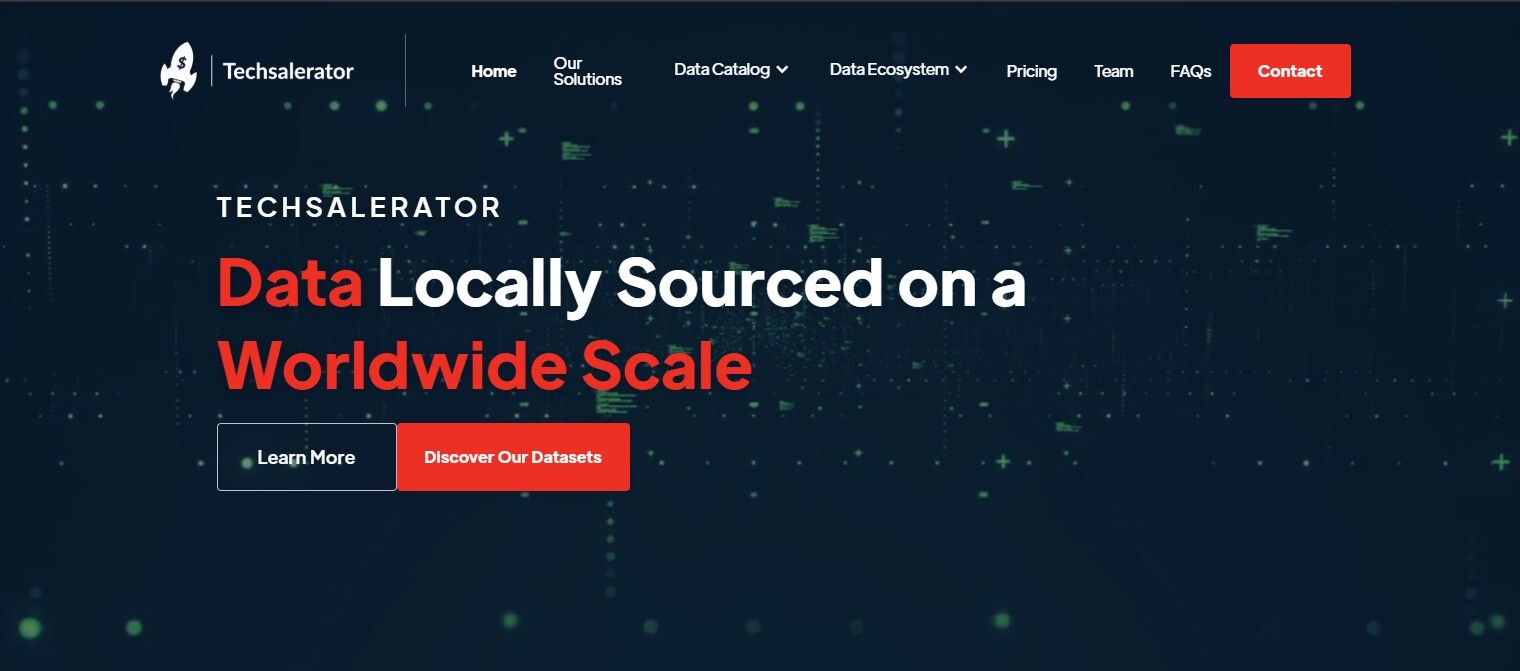
Techsalerator focuses on global company and POI data, delivering large-scale firmographics, locations, and attributes that feed enrichment, segmentation, and geo-use cases. Teams use it to standardize company records around consistent names, URLs, and addresses; append attributes like industry, size, and technologies; and blend POI layers (stores, branches, facilities) for territory planning and local prospecting. Delivery is flexible - bulk files for data ops, APIs for real-time lookups, and marketplace listings - so ops can slot it into existing warehouses, CDPs, and BI stacks without rebuilding pipelines.
In the U.S. and internationally, Techsalerator is often paired with CRM/MA systems to cleanse duplicates, normalize company identifiers, and keep routing rules accurate. Geo-heavy motions (field sales, franchise, retail, logistics) benefit from POI depth that supports drive-time targeting, trade-area analysis, and competitive mapping. For marketing, consistent domains and locations improve match rates across ad platforms and ABM tools. If your strategy relies on company/POI breadth, location context, and bulk delivery at reasonable cost-per-record, Techsalerator provides a pragmatic foundation you can enrich further with contact or intent sources as needed.
3) Dun & Bradstreet

Dun & Bradstreet is widely known for commercial data, corporate family trees, and risk indicators that are valuable in credit, supply chain, and enterprise sales contexts. U.S. companies often rely on D-U-N-S numbers as a durable key that links records across systems, which makes D&B a popular choice for master data management. If your workflows include compliance checks, supplier onboarding, or distributor vetting, D&B’s risk and financial metrics add context beyond standard firmographics.
For go-to-market teams, D&B offers search and segmentation by size, industry, and other operational signals, plus linkages that reveal large corporate structures. That matters when building account hierarchies or deduplicating inbound leads. Many organizations integrate D&B with their ERP and CRM to maintain a consistent business identity across sales, finance, and procurement stacks. While D&B is often associated with large enterprises, smaller teams use it as a reference backbone to improve match rates and standardize data before layering on contact-level sources. The combination of identifiers, linkage, and risk context makes it a strong anchor when accuracy and governance are top priorities in the U.S. market.
4) ZoomInfo

ZoomInfo combines a broad professional and company graph with tools that help sales and marketing teams find and prioritize prospects. The platform offers rich filters for firmographics, roles, and seniority, along with additional layers like technographics and buyer intent. Those layers help identify accounts that match your ICP and are showing interest in relevant topics, which improves timing and relevance for outbound campaigns.
In the U.S., ZoomInfo is used for building targeted lists, syncing contacts into CRM and marketing automation, and powering sales development workflows. Org charts and department mapping help reps navigate larger accounts. Integrations with common systems keep data flowing into sequences and routing rules without manual exports. For operations teams, governance features and periodic refreshes support data hygiene. If your strategy depends on contact-level scale, multi-channel outreach, and a steady stream of new targets, ZoomInfo offers a consolidated environment to search, score, and activate prospects in the U.S. and beyond. Many teams pair it with a separate company master for standardization, then rely on ZoomInfo to fill in people and engagement signals.
5) Data Axle

Data Axle is a long-standing source for U.S. business coverage, including extensive representation of small and mid-sized companies. That depth is useful for field sales, local services, and any motion where capturing the long tail of the market matters. Records typically include core firmographics like address, industry codes, employee range, and estimated sales, along with phone and primary contacts where available. A hallmark has been a strong verification cadence, which benefits teams that still rely on calling programs and direct mail.
Marketers use Data Axle to assemble location-based lists, run geotargeted campaigns, and clean up address data before physical outreach. Sales teams like the breadth of small business coverage for territory planning and prospecting in specific metros or ZIP codes. Data Axle is also a practical choice for CRM appends when your database contains many local businesses or fragmented records. If your U.S. strategy focuses on comprehensive coverage, especially in service-led industries and SMB segments, Data Axle can supply a broad base that complements other enrichment and engagement tools.
6) Apollo.io
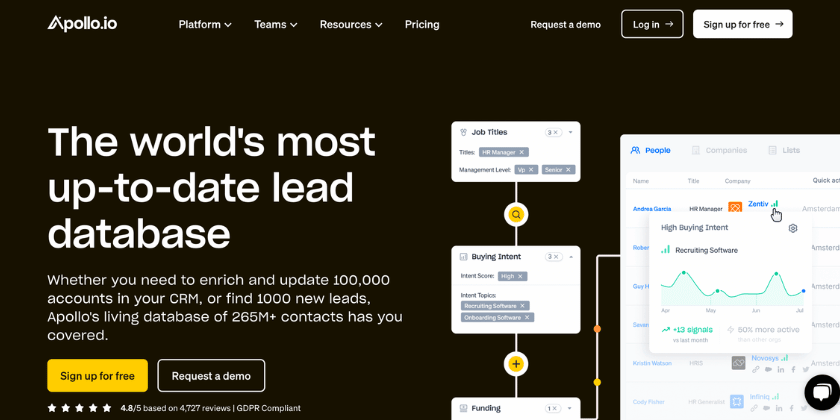
Apollo.io blends a large contact and company catalog with built-in outreach capabilities, which makes it attractive for teams that want data and engagement in one workspace. The platform supports list building with firmographic and role filters, then lets users launch sequences, track replies, and dial prospects from the same interface. That consolidation reduces tool switching, which is helpful for smaller U.S. teams moving quickly.
For operations, Apollo offers CRM integrations and data enrichment to keep records aligned as reps prospect. Some teams use Apollo as their first pass for net-new contacts, then route qualified accounts into their core CRM for long-term management. The emphasis on speed and activation suits growth-stage companies that iterate on messaging and targets each week. If your U.S. go-to-market leans on agile outbound, Apollo provides a practical way to test markets, stand up sequences, and learn quickly without stitching together multiple tools. Pair it with a trusted company master when you need stricter governance or standardized identifiers.
7) Clearbit

Clearbit focuses on API-first enrichment and website intelligence, which can streamline modern marketing operations. In the U.S., teams use Clearbit to shorten forms, enrich inbound leads in real time, and personalize sites for anonymous visitors. Firmographics and technographics help drive smarter routing and scoring, so high-fit leads reach sales faster with fewer manual touches.
The platform fits well in stacks that already rely on automation. You can enrich records inside Salesforce, HubSpot, and other systems, then use that data to trigger segmented campaigns or adjust chat playbooks. Clearbit Reveal can identify visiting companies from IP and help you tailor web experiences by industry or size. For product-led growth or demand gen teams, this reduces friction and improves conversion without asking buyers for more fields. In short, Clearbit is a good match when your U.S. strategy emphasizes real-time decisioning, form optimization, and precise targeting that depends on consistent, structured company attributes.
8) SalesIntel

SalesIntel emphasizes human-verified contacts and frequent revalidation, which benefits U.S. teams that depend on phone outreach and accurate email delivery. You can search by standard filters, add intent and technographic overlays, and export contacts with higher confidence that details will work in practice. The platform also offers a research-on-demand option when a key contact is missing, which is useful for account-based programs.
For operations, verified phones and periodic refreshes reduce wasted dials and bounced mail, which lowers campaign costs. SalesIntel integrates with CRMs and engagement tools, so reps can push contacts directly into cadences. This is a practical choice when quality matters more than sheer volume, such as targeting specific roles in regulated industries or reaching executives who are harder to contact. If your U.S. motion depends on the phone channel and timely connects, SalesIntel’s focus on verification can improve productivity and downstream conversion.
9) Lead411
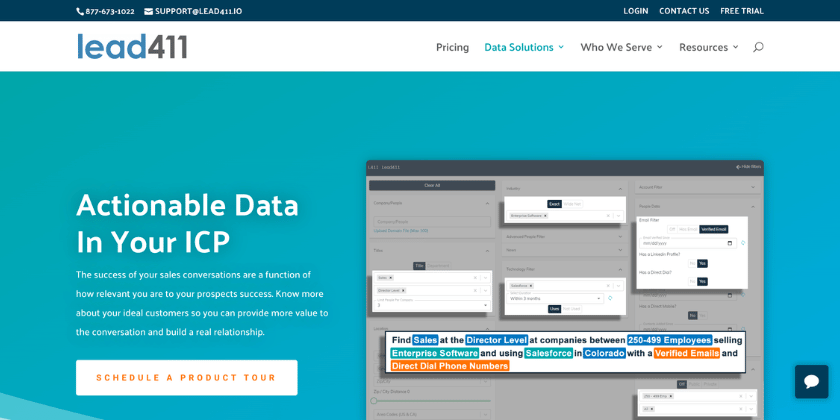
Lead411 pairs contact data with sales triggers that help with timing. U.S. users build lists by title, function, company size, and location, then overlay signals like hiring, funding, or growth to decide who to approach first. Those signals are effective when you want to open with something relevant, which raises reply rates and shortens sales cycles.
The platform supports exports to CRM and engagement tools, and offers a browser extension for quick capture while researching on LinkedIn or company sites. Lead411 is often adopted by SDR teams that value a steady cadence of triggers to guide prospecting each week. If your pipeline strategy emphasizes striking while interest or change is evident, adding Lead411’s signals to your list building can focus activity on accounts most likely to engage now. Pair it with a company master for consistent firmographics and linkage when you need broader governance.
10) Lusha

Lusha is popular for its simple workflow. The browser extension reveals direct dials and emails while you browse professional profiles, and the web app supports bulk list building with common filters. U.S. sales teams like Lusha when they need quick contact discovery inside day-to-day research without switching contexts. It also integrates with CRMs so you can save records without manual entry.
Because Lusha is easy to roll out, many organizations use it to augment other systems. Reps can validate or supplement a contact found elsewhere, then send it into a cadence. Small teams appreciate that it speeds up the first step of outreach, which is finding a reliable way to reach the right person. For a U.S. motion where reps work a defined account list and need to fill gaps with accurate phones and emails, Lusha provides a fast, lightweight companion that fits the browsing habits of modern prospectors.
11) Seamless.AI
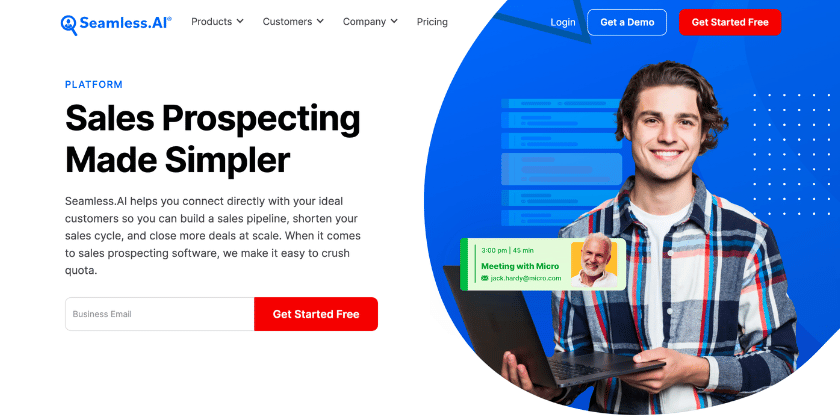
Seamless.AI positions itself as a continuous search engine for B2B contacts. Instead of relying only on a static catalog, it discovers and validates contact information as you query. In the U.S., that helps teams surface new prospects and fill missing data points while they work through a territory. A web app and extension support both list building and one-off lookups during account research.
For operations, the appeal is a steady flow of fresh contacts that can feed cadences and calling blocks. Seamless integrates with CRMs and engagement tools to reduce manual steps. It is well suited to high-velocity prospecting motions, where reps want to search, verify, and add records in the same session. If your priority is momentum and daily list expansion for U.S. outreach, Seamless can complement a more governed company master by keeping the top of the funnel supplied with net-new contacts across your ICP.
12) Cognism
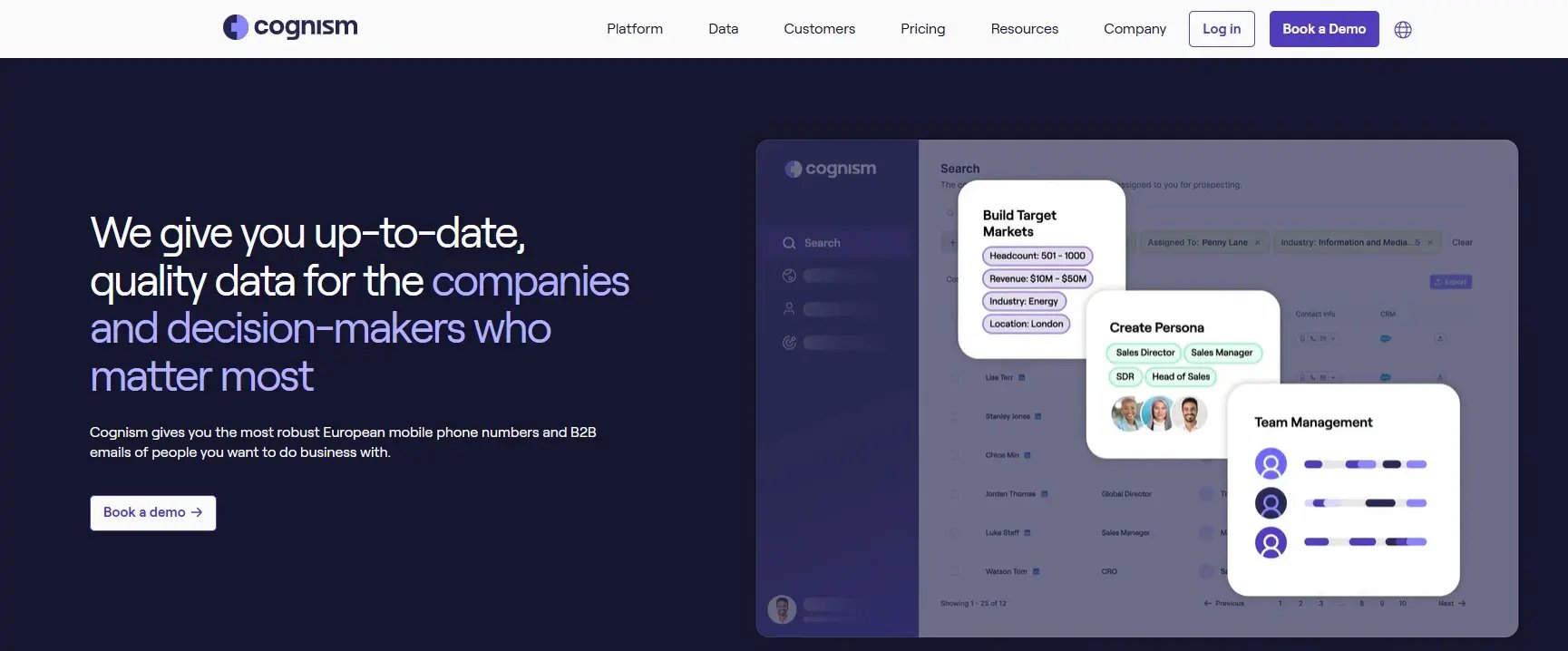
Cognism focuses on accuracy and compliance, with strong coverage in Europe and growing reach in the U.S. For cross-border teams, this combination is valuable. The platform provides verified emails and mobile numbers, with processes designed to align with privacy regulations. It also includes intent overlays and a browser extension for capturing contacts during research.
In U.S. programs, Cognism serves teams that need dependable direct dials and a clear approach to consent and opt out. Sales leaders often pair Cognism with a separate account intelligence tool to handle broader firmographics and news, while relying on Cognism to supply the specific people and numbers that get results. If your organization sells into regulated industries or runs outbound into Europe and North America, Cognism’s emphasis on governance and mobile reach can help you execute at scale while maintaining a consistent standard for data handling.
13) Crunchbase
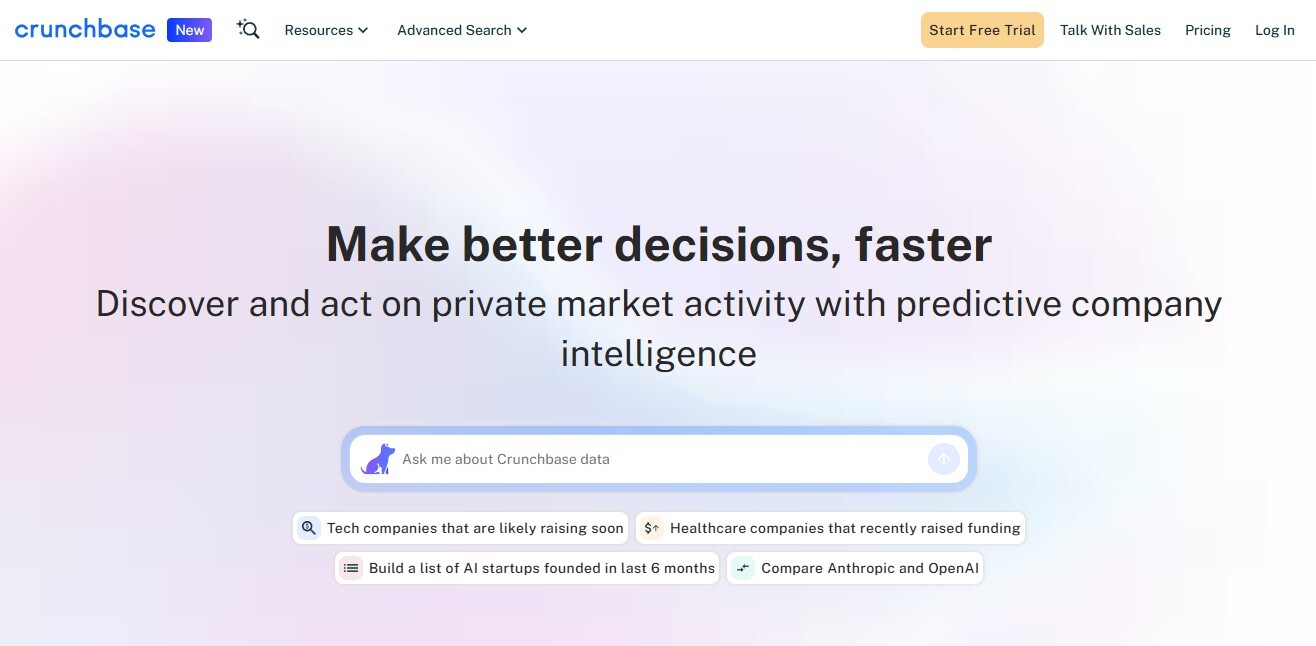
Crunchbase offers company intelligence rather than broad contact lists, and it excels in tracking growth signals for U.S. businesses. You can filter by location, size, industry, and funding stage, then build target account lists based on recent investment, acquisitions, or market momentum. This is valuable for outbound teams that prioritize high-growth firms and want to tailor messaging to recent milestones.
Many sales teams use Crunchbase to score accounts, prioritize territories, and guide partner outreach. The data helps marketers shape campaigns around relevant segments like newly funded SaaS companies or fast-growing fintech in specific metros. Integrations and exports make it straightforward to sync firmographics and growth context into CRM. Combine Crunchbase with a contact source to find the right people inside those target accounts, then use intent or trigger tools to time outreach. For strategy and research, Crunchbase remains a reliable source to understand who is gaining traction in the U.S. market.
14) Demandbase Sales Intelligence (InsideView)

Demandbase Sales Intelligence, known historically as InsideView, brings account and contact context into the systems sellers already use. In a U.S. workflow, you can view firmographics, key people, news, and social insights directly inside your CRM record. That embedded approach saves time and encourages consistent research before calls and emails. Alerts help reps stay current on leadership changes, product launches, or media coverage that can serve as timely reasons to connect.
Beyond research, the platform supports list building and profiling for ABM. Marketing teams use it to validate fit and refine account tiers, while sales ops rely on it to enrich records and reduce manual updates. If your goal is to make every account interaction better informed without adding extra steps, InsideView’s integration style is a strong fit. It works well alongside a separate contact acquisition tool, giving sellers the context they need while sequences run in your engagement platform.
15) UpLead

UpLead focuses on practical list building with verification at the point of export. For U.S. teams, that means you can search by firmographics and tech filters, then pull contacts with confidence that emails will deliver. The workflow is straightforward and friendly for SDRs who want to assemble a list quickly and move it directly into sequences with minimal cleanup.
Operations teams appreciate that UpLead reduces bounce-related noise and keeps sender reputation healthier. It also integrates with common CRMs and engagement tools so lists move smoothly into your existing playbooks. For small and mid-sized sales teams, UpLead’s emphasis on accuracy over sheer volume can yield better connect rates and a more predictable pipeline. It is a practical companion to an account intelligence or company master tool, supplying the contact layer you need to activate your U.S. ICP.
16) RocketReach
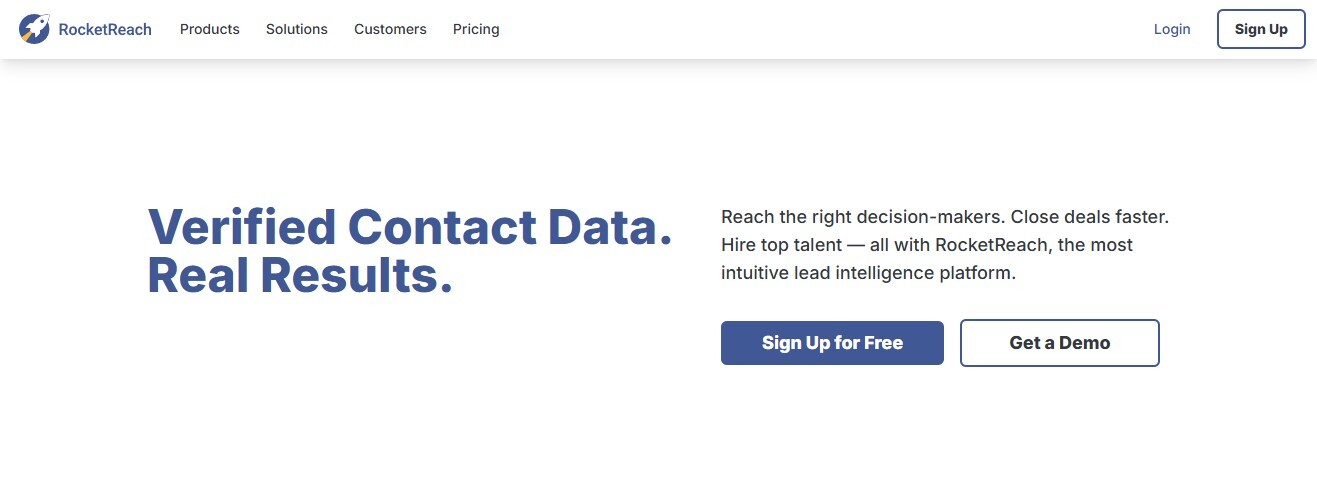
RocketReach is a widely used contact lookup tool that helps researchers and sellers find emails and phone numbers for specific people at U.S. companies. It is particularly handy when you already know the target account and titles you want, and you need a fast way to retrieve direct contact details. The interface supports search by name, role, company, and domain, and results can be exported into CRM and engagement tools.
Many teams keep RocketReach as a utility for gap filling. When a lead comes in without a direct dial, or when a strategic account requires outreach to a new stakeholder, RocketReach can supply the missing details. It is also useful for one-off projects like executive outreach or event invites where precision matters. Pair RocketReach with a company data source for segmentation and an intent layer for timing, and you have a simple, effective stack for targeted U.S. outreach.
17) People Data Labs
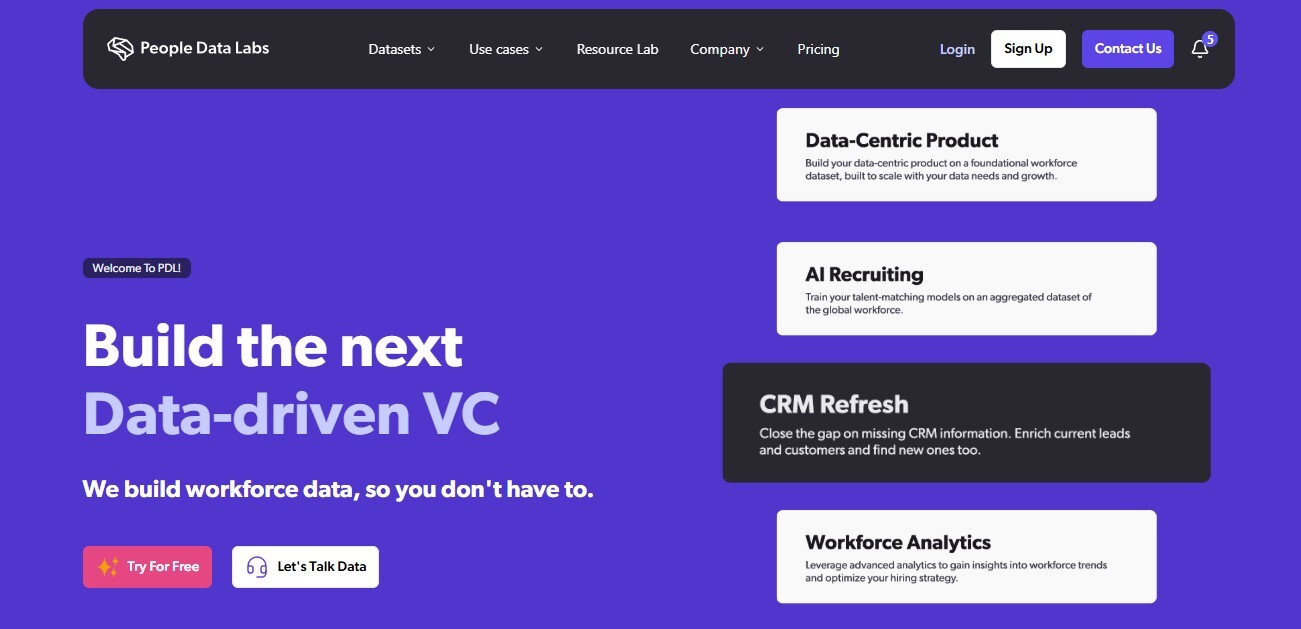
People Data Labs is an API-first enrichment provider that supplies people and company graphs at scale. Product and data teams in the U.S. often adopt PDL when they need to build features that depend on large-volume enrichment, such as scoring, routing, fraud checks, or onboarding flows. The focus is on developer experience, with flexible endpoints and field coverage that can be tailored to your schema.
For go-to-market, PDL can enhance records with standardized fields that support segmentation and analytics, while engineering teams appreciate that it embeds cleanly into pipelines and data warehouses. If your organization wants to bring enrichment closer to your product or data platform, PDL offers a technical path to do so without manual exports. It is a strong fit for API-driven stacks where scale, uptime, and documentation are as important as the fields themselves.
How to Match a Provider to Your Needs
Not every U.S. B2B data platform is built for the same type of buyer. The real question is less about “Which is the best provider overall?” and more about “Which features and delivery models align with my company’s size, budget, and go-to-market strategy?”
- SMBs starting outbound campaigns may value simple tools with quick list-building functionality and lower entry costs.
- Mid-market companies scaling ABM often look for deeper prospecting options, marketing automation integrations, and the ability to layer on signals like technographics or intent.
- Enterprises and compliance-driven teams tend to prioritize bulk datasets, transparent sourcing, and robust governance features that integrate with multiple internal systems.
- Privacy-sensitive organizations might focus on providers that demonstrate strong alignment with regulations such as CCPA and GDPR, along with clear opt-out mechanisms.
The point is not that one approach is universally “better,” but that each platform type serves different operational needs depending on growth stage, compliance requirements, and sales motion.
FAQ Section
- What makes U.S. B2B data different from other markets?
The U.S. has the largest business population globally, but data is spread across multiple federal and state registries. This creates fragmentation that providers must normalize into usable formats for sales, marketing, and compliance. - How often should B2B data be refreshed?
Best practice is continuous or monthly updates. At a minimum, quarterly refreshes help reduce bounce rates and ensure CRM records remain accurate. Update cadence is a key factor to consider when comparing providers. - Do small businesses require the same data coverage as enterprises?
Yes, though the focus differs. SMBs represent over 99% of U.S. businesses, so providers with strong SMB coverage support go-to-market breadth. Enterprises benefit more from corporate linkage and hierarchical data that clarifies parent-subsidiary relationships. - Is CCPA compliance relevant for B2B data?
Yes. The California Consumer Privacy Act (CCPA) applies to personal and professional information. Providers must have transparent sourcing and clear opt-out mechanisms to meet compliance obligations. - What’s the difference between bulk datasets and SaaS access?
Bulk datasets are better suited for CRM enrichment, analytics, and compliance programs. SaaS platforms offer user-friendly interfaces and prospecting workflows. The right choice depends on whether a team values scale and governance or speed and ease of use.
Resources and Links
- NAICS Industry Codes: U.S. Census Bureau NAICS Lookup
- U.S. Small Business Statistics: U.S. Small Business Administration
- CCPA Guidance: California Attorney General – CCPA Portal
- Securities and Exchange Commission (SEC) Filings: SEC EDGAR Database
- Dataset Access: InfobelPRO Custom Datasets




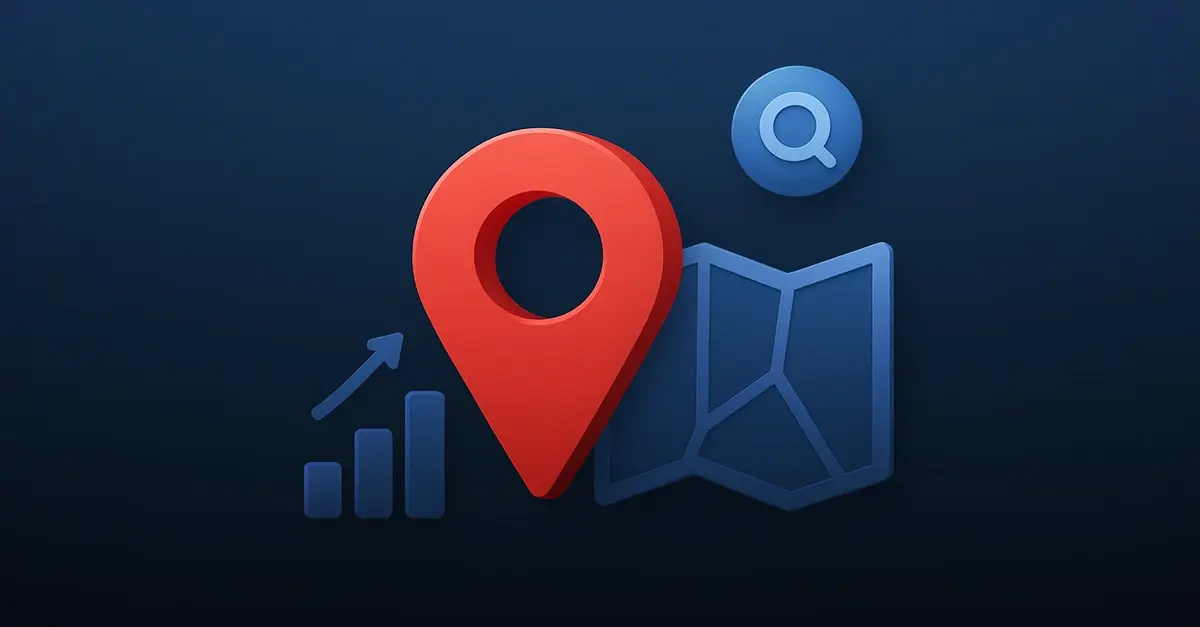
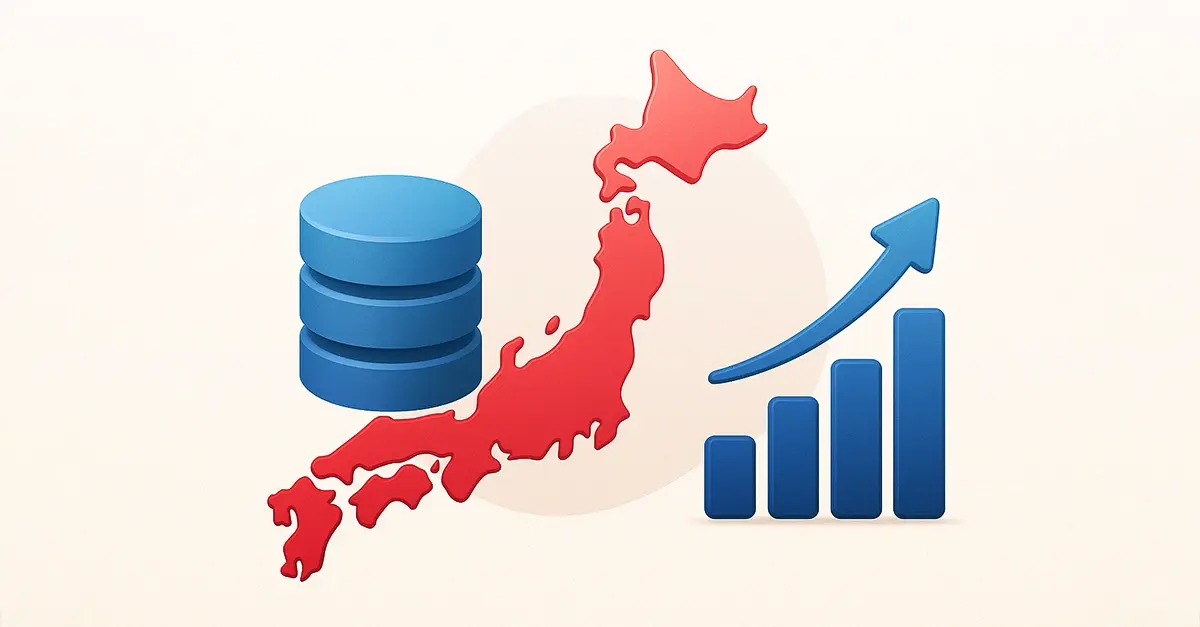
Comments